The Rummage Sale was a time-honored (and much loved) fund-raising tradition at many churches and other bay area non-profits. During the 1950’s and 1960’s, All Saints (Palo Alto), St. Mark’s, Christ Church (Los Altos) and Holy Trinity (Menlo Park) were all holding regular rummage sales. In February of 1957, the Palo Alto Times even announced that it was “Rummage Sale Season” and listed a variety of upcoming sales held by groups ranging from the Los Altos Quota Club to the Harker Mothers to the Palo Alto Art Club (Palo Alto Times). In the church, rummage sales were typically organized and run by the Women’s Auxiliary or ECW and were a way to raise money for the various projects the women of the church worked on. Although they were fun and provided good fellowship, rummage sales were huge amounts of work and not without politics!

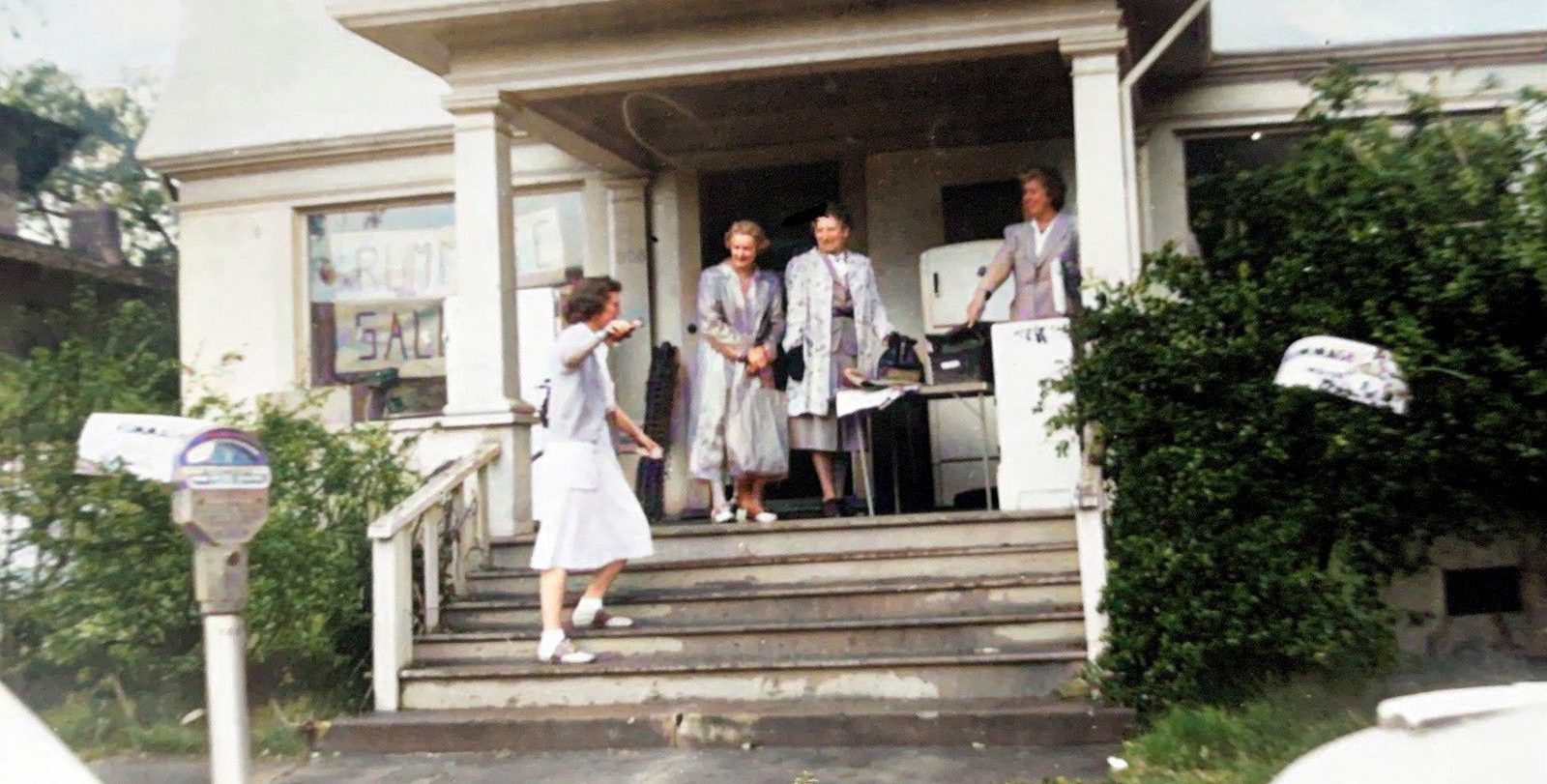
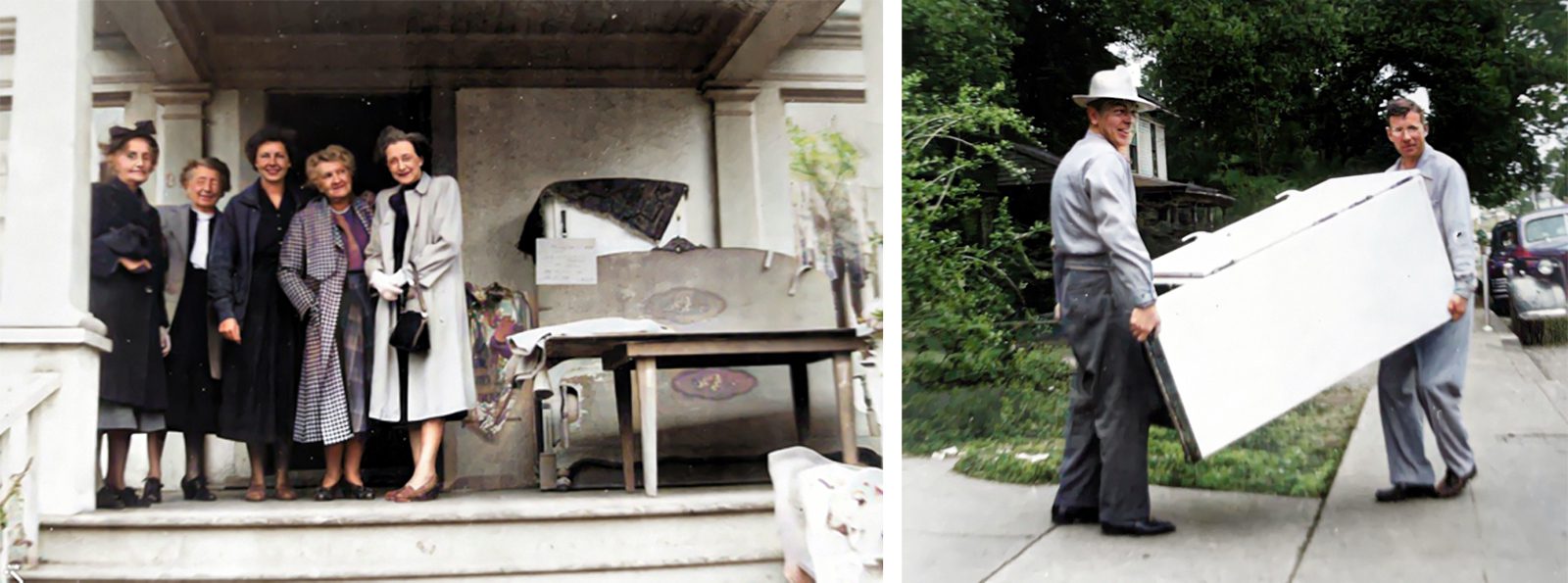
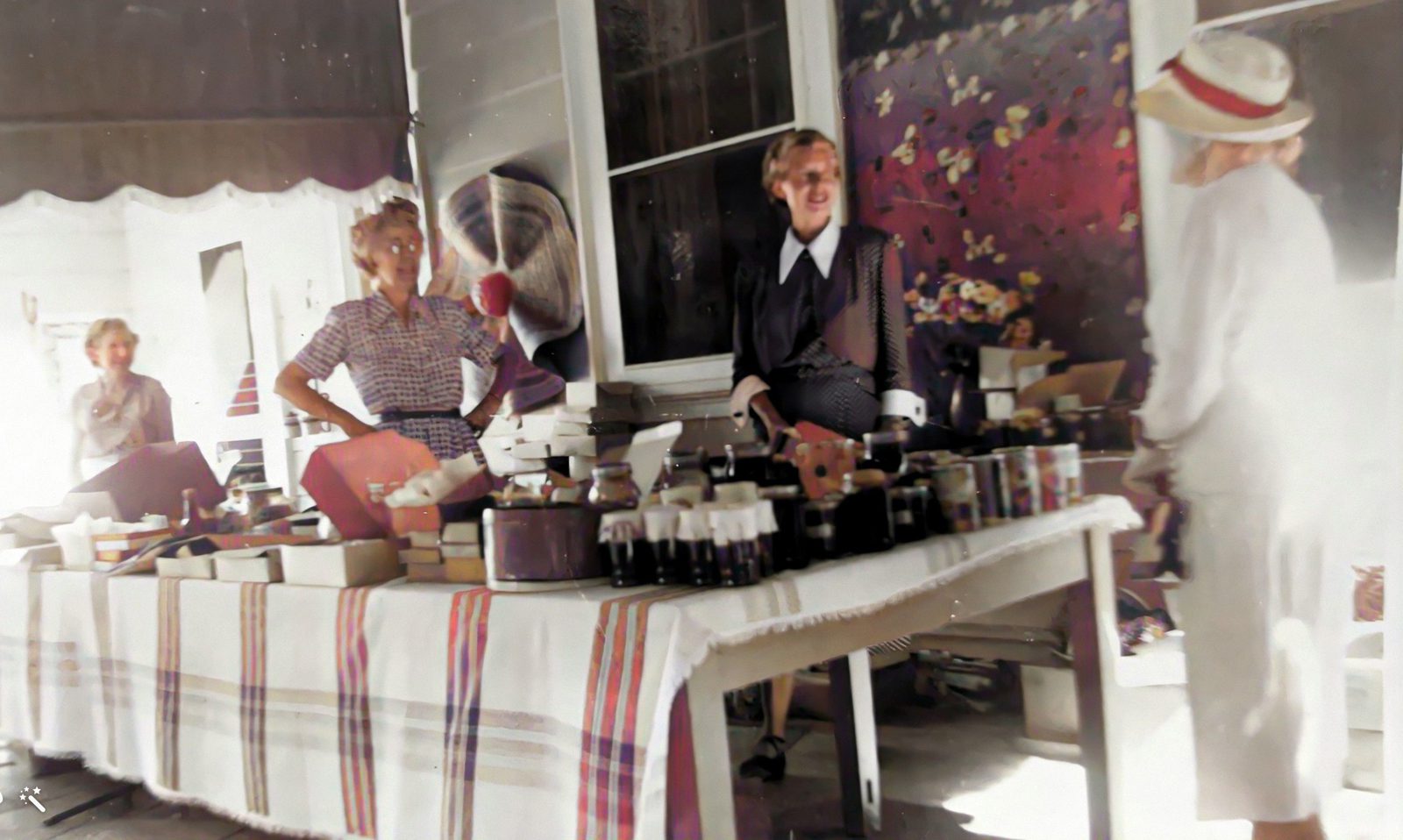
Since church rummage sales are no longer as popular, we are forgetting everything that is involved in putting them together. Fortunately Pat Jenkins, who was the St. Mark’s Rummage Sale chair for about 15 years, shared some great memories with me. Preparations began as throughout the year the rummage sale committee collected donations for everything from books, to clothes, to furniture to…well…just about anything! The church even offered a pick-up service for furniture and donations!
Volunteers met every Monday and sorted, priced, repaired, and washed items and of course discarded the rejects. One of Pat’s favorite memories was the day she spotted a beautiful roasting pan that someone had donated. She was excited to think how much they could charge for the pan….that is until she opened the lid and found a moldering leg of lamb that had been left in the pan when someone donated it! Pricing was overseen by the committee and standards developed over time about how much certain items should cost. The Director and more experienced volunteers had final say in pricing. Yes there were some conflicts and squabbles about pricing!
Everything had to be carefully sorted and stored until the sale (so the bigger the sale, the more space was required for storage). Pat remembered that St. Mark’s used the Sunday School Rooms that used to connect to the Chapel as well as the wing of Sunday School Rooms (no longer there) for collection and storage. Eventually the church built a big shed just for Rummage Sale storage. In the later years, St. Mark’s ran two rummage sales annually so this became an all year-round operation.
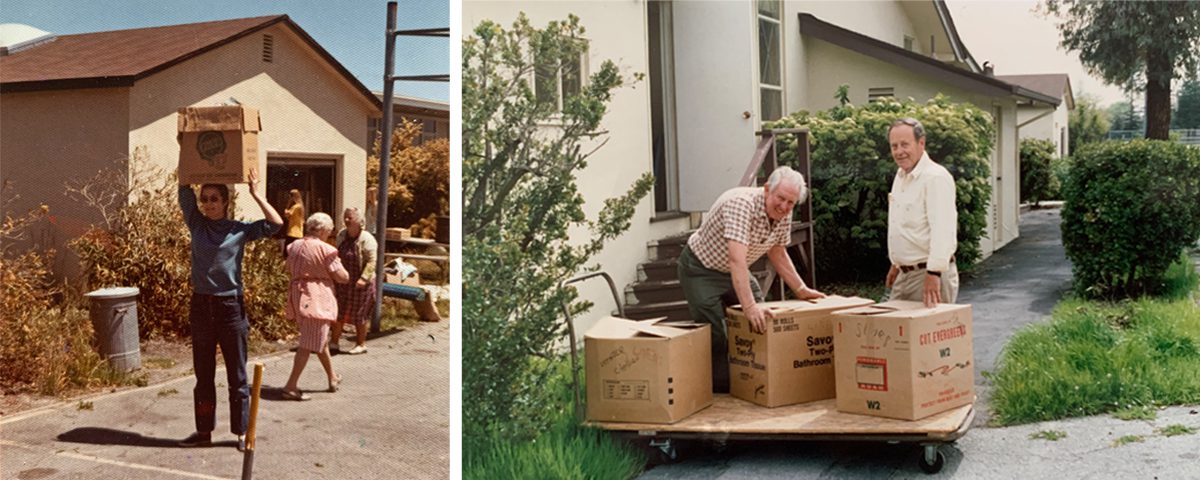
The sale took place in the Sunday School rooms and Parish Hall of the church and typically lasted for several weekdays. It was staffed by volunteers from the ECW and others from the church. Different volunteers would be in charge of different “areas”- such as furniture, books, art, and children’s clothes. There were certain areas that were more coveted than others. As with most organizations, volunteers had to start at the bottom and work their way up to the choicer assignments. For example, Pat remembered that Mary Kennedy was in charge of “Better Dresses” for many years.
One of the ultimate jobs was to be a counter. Pat recollected that the counters met in a locked room where they drank martinis and counted the sale proceeds. She said it was many years before she proved herself enough to even be allowed to enter the counter’s room.
The bigger church rummage sales (especially St. Mark’s and Trinity Parish in Menlo Park) were well known and customers came back year after year to shop there. The prices were very reasonable and It wasn’t uncommon for long lines to form in advance of the opening of the rummage sale. When the doors opened, customers rushed in and began the hunt for a bargain. Anne Vosti was close friends with long-time St. Mark’s Parishioner, Gladys Kirkman. A stalwart volunteer at the Trinity rummage sales (and by the way, the first woman Senior Warden at Trinity), Anne enjoyed attending St. Mark’s Rummage Sales just to shop. One time she found a spotted a beautiful Steuben bowl that she quickly snapped up for $10 – that is after she had to borrow the $10 from Gladys Kirkman!
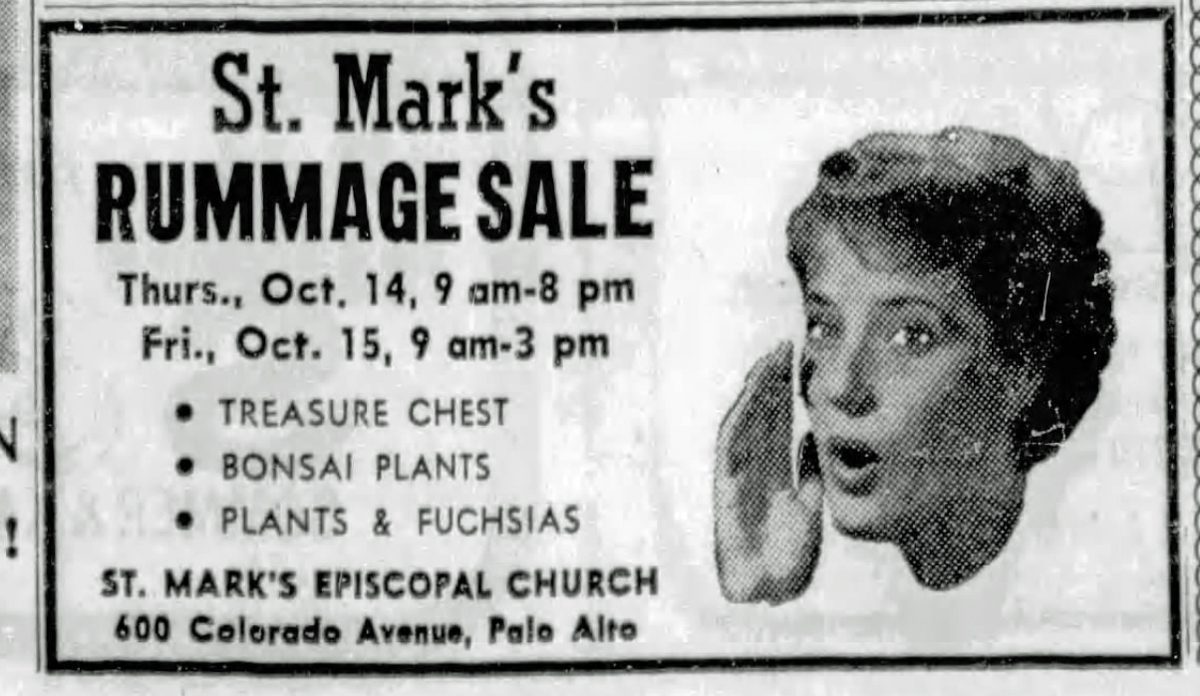
The Rummage Sale planners also tried to create special events and booths to entice buyers. In 1964, St. Mark’s announced that a feature of that year’s rummage sale would be a special “Treasure Chest.” The chest would feature “antiques, jewelry, pictures, frames, books, and other special gift items.” Bidders would have the opportunity to win the Treasure Chest. Other special items that year were Bonsai plants donated by Kusamura Bonsai Club (who still meet monthly at St. Mark’s) and a bake sale by the Episcopal Young Churchmen (Palo Alto Times). In 1960, the sale included special Costumes created by a parishioner and a Christmas booth. In 1971, the sale featured Halloween and Christmas decorations and notions and jewelry (including “a handmade raw silk bedspread, a silver and tortoise shell snuff box, a Chinese pewter tea caddy and a sterling silver dresser set) (Palo Alto Times). The Youth Group sold hot dogs and baked goods.
An especially effective publicity piece was a full page article in the Palo Alto Times in 1968 which profiled what they called “The House of Rummage.” This was the home of St. Mark’s Parishioner Audrey Werson which was largely furnished with St. Mark’s Rummage finds. In the article the church women mention wondering about:
“…the Stanford student who bought a sofa for $10. The student didn’t have a way to get his purchase home, so he took the sofa cushions and said he’d come back later for the frame. He never returned and the church women couldn’t get in touch with him because he’d left neither his name or address. They kept the cushion-less couch for about a year after that, but finally decided to put it up for sale again. Who would buy a couch without cushions? An eager rummage shopper, that’s who.” (Palo Alto Times)


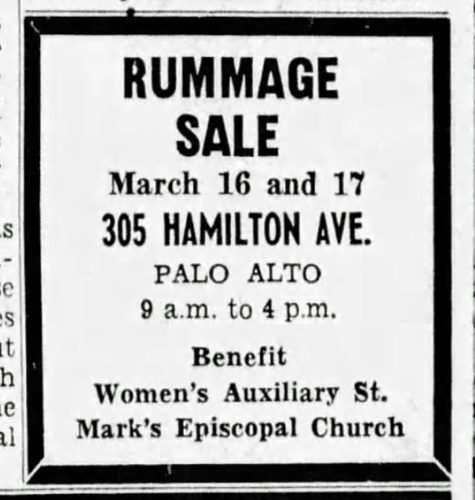
And one of the all-time favorite events for everyone who attended these rummage sales was the $1 bag. On the last day at the last hour of the sale, you could buy a grocery bag for $1 and pretty much anything you could stuff in that bag was yours. This was a favorite part of the rummage sale for me as a child (at Trinity, Menlo Park) and I do remember there was some strategic hiding of items in the hopes that no one would find your hidden treasure before the $1 bag sale.
St. Mark’s jumped on the rummage sale band wagon right away in 1948. Their first sale, conducted by the St. Mark’s Women’s Auxiliary, was held on Thursday, September 1th, 9am-5pm at 408 University Avenue in Palo Alto. An article in the Palo Alto Times noted that the sale would benefit the new St. Mark’s Sunday School program and would include children’s clothes, toys, shoes, women’s and men’s apparel, furniture, art and plants and notions. The sale netted $649.75 (which is pretty impressive since that’s about $8,000 in today’s dollars). The money was directly handed over to the Women’s Auxiliary to use to pay for Sunday School expenses (Palo Alto Times).
Rummage Sales initially raised funds for the Women’s Auxiliary projects such as the Sunday School. In later years they went to the General Fund. By the end of the sales, the funds went to “missions in the United States and other parts of the world.”
St. Mark’s even hosted another well known local Rummage Sale – The Stanford Auxiliary of the Children’s Convalescent Hospital sales also happened twice a year. It was truly the era of the rummage sale. But all good things must come to an end.
At least one of the Rectors at St. Mark’s (Canon West) hated the Rummage Sales. Pat Jenkins said Canon West was frustrated by the autonomy of the ECW and their projects and their control of the money they raised. It was also possible he resented the amount of volunteer labor the sales required and how much space they took up on campus. Whatever the reasons, he did reference the Rummage Sales as one of the reasons for his resignation (but that’s another story).
In the end, the much-loved Rummage Sales weren’t stopped by an angry Rector, they just gradually faded away…not just at St. Mark’s, but at other local churches too. Why? They were just too much work. As the role of women changed and more women worked outside of the home, there was not enough volunteer labor to put in the hours of time required to organize and staff a Rummage Sale. As time went by they were staffed mostly be older, retired volunteers and eventually were just not sustainable and were no longer the best use of time and talent for fund raising.
There’s still a lot of nostalgia and fond memories of the sales – anyone who grew up in the church and volunteered at the sale and shopped at the sale and especially wrangled some treasures into a $1 Bag still misses them. If you have any special memories of working at or shopping at a St. Mark’s Rummage Sale, I hope you will comment below!
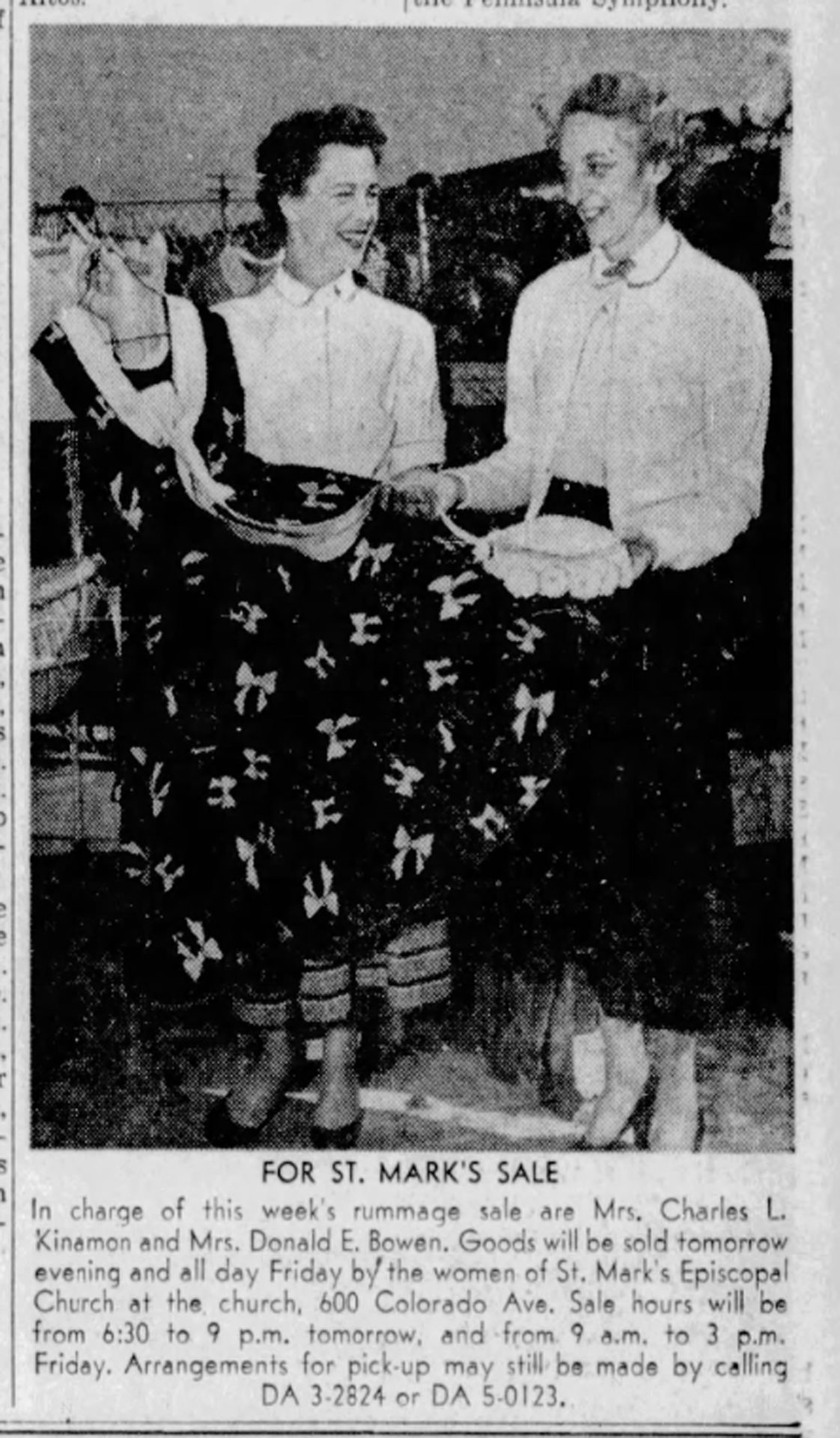
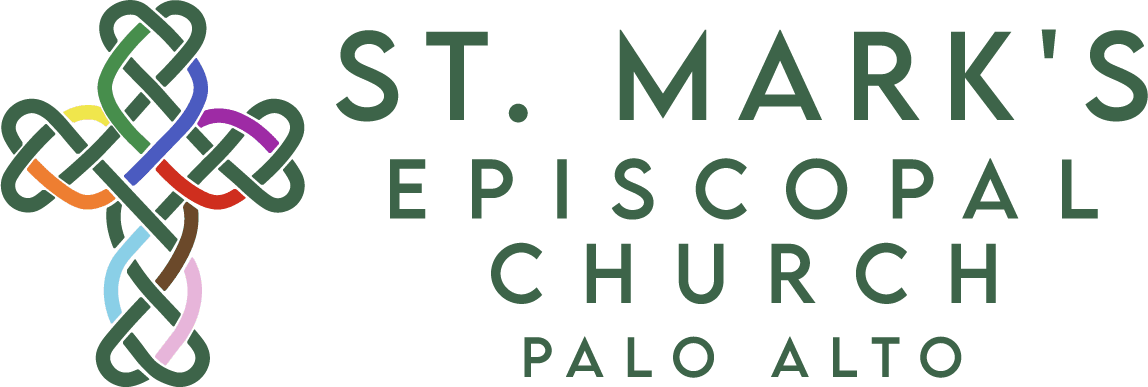
OMGoodness…
I so remember these sales. Mom (Pat Jenkins) even ‘hired’ child labor; her two daughters Sally (me) and Sue to help where ever we could. We loved the glittery jewelry, fancy dresses and shoes. So much work, fun, smiles and love shared during these times. Thanks for the memories.
Sally Jenkins
As kids, we loved the St. Mark’s Rummage Sales! I bought my first LPs at one in about 1976 – Glenn Gould playing Beethoven piano sonatas, and Pablo Cruise – Worlds Away.